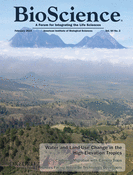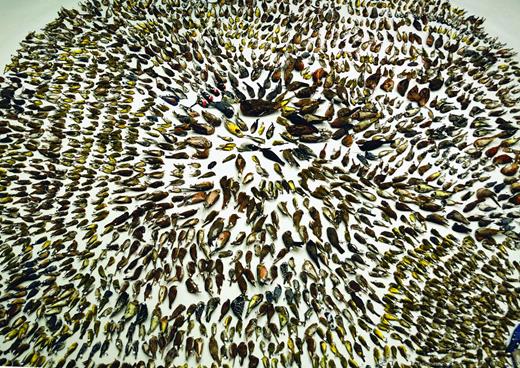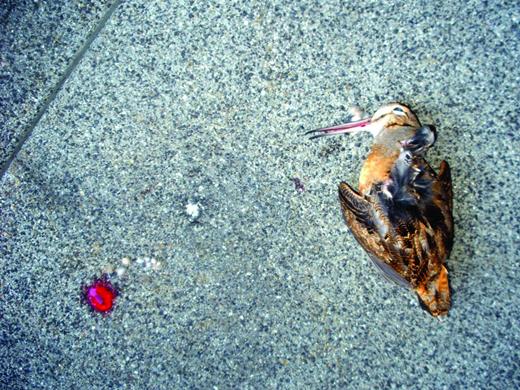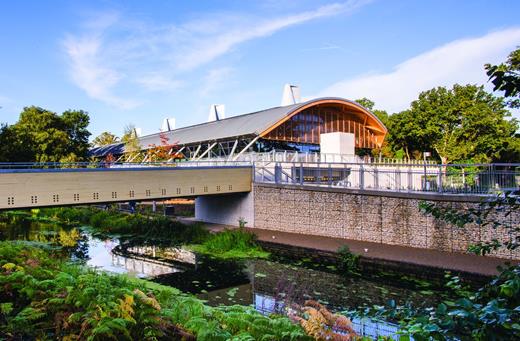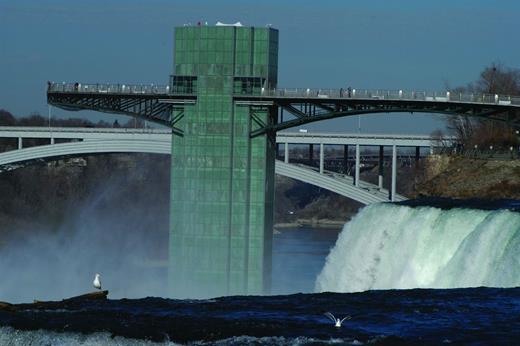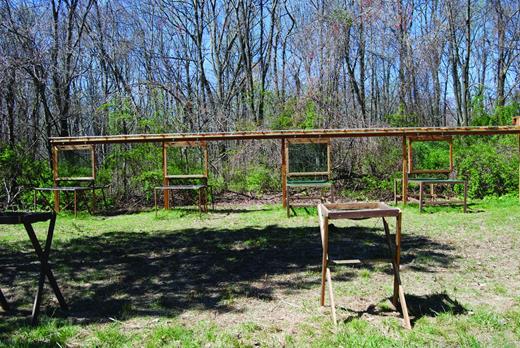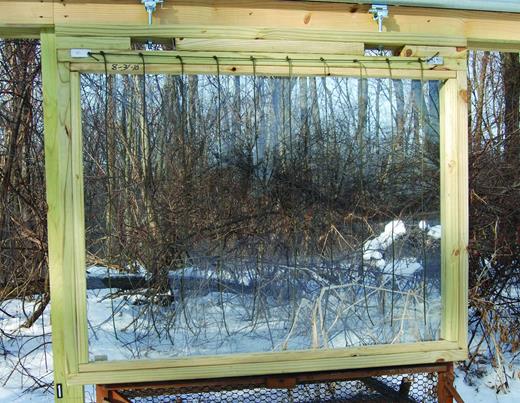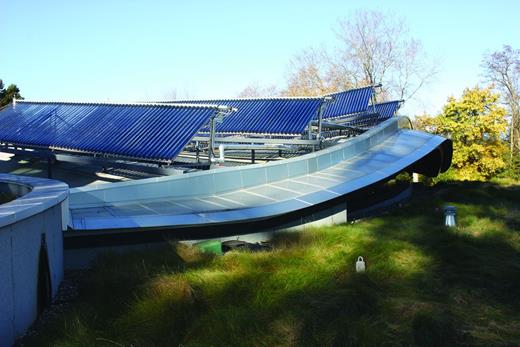-
PDF
- Split View
-
Views
-
Cite
Cite
Lesley Evans Ogden, Does Green Building Come up Short in Considering Biodiversity?: Focus on a growing concern., BioScience, Volume 64, Issue 2, February 2014, Pages 83–89, https://doi.org/10.1093/biosci/bit019
Close - Share Icon Share
The bodies of over 2400 migratory birds that died in collisions with buildings while trying to navigate through Toronto in 2012, displayed at the Royal Ontario Museum in the Schad Gallery of Biodiversity, in March 2013. Photograph: Kenneth Herdy, Fatal Light Awareness Program.
The Monday morning body count outside the Federal Bureau of Investigation (FBI) building in Chicago was 10. “It was carnage,” says FBI Special Agent Julia Meredith. The bodies were those of wild birds lethally striking the building's exterior windows. Meredith, recalling the beautiful yellow and orange warblers killed in the midst of fall migration, says they were “spectacular birds that we just don't see in Chicago very often.” It was especially surprising because the building had achieved a platinum rank from the US Green Building Council's Leadership in Energy and Environmental Design (LEED) rating system. Meredith, who has a degree in environmental science and a keen interest in birds, began regularly calling the Chicago Bird Collision Monitors (CBCM) to deal with the dead and injured birds.
An American woodcock (Scolopax minor) that died from colliding with a window at the Federal Bureau of Investigation building in Chicago. Photograph: Annette Prince.
“We had a building that was harming federally protected birds,” explains Annette Prince, director of the all-volunteer CBCM, which is run under the auspices of the Chicago Audubon Society. “So it seemed very fitting, since this is a federal agency in charge of making sure federal laws are carried out, that they would set the example that we can do better.” Meredith alerted property managers and initiated a lengthy process to bring the FBI management on board, addressing concerns about security and aesthetics. The solution: mesh similar to volleyball netting attached about 10 inches from the window. Reaching up to the second story, the netting mitigates the enticing reflection of trees. Meredith estimates that it has reduced casualties by 80%.
Green buildings and their certification schemes have become icons of sustainability in the built environment, but green building may have unintended consequences for nonhuman species. Has the predominant focus on energy, water, and materials left biodiversity in the dust? That's a question appearing on the radar for the green building community, fueled by conversations among conservation biologists, architects, urban designers, engineers, and wildlife advocates.
Historical roots
Green or sustainable building traces its North American roots back to the 1970s, when the oil crisis, combined with a burgeoning environmental movement, led to interest in low-energy-use buildings. The European embrace of sustainable building design dates back further, explains James Axley, a senior research scientist at the Yale School of Forestry of Environmental Studies and professor emeritus at the Yale School of Architecture. “Europe was devastated by World War II,” he explains, and so new building technology thrived there—not so in the United States. In the early 1950s at US universities, architectural engineering building technology programs dried up, explains Axley, as funding for space, war, and medical technology increased. Building technology programs reemerged only decades later. Fast forward to the present day, and the initial green building focus on energy—in the United States and elsewhere—has expanded to encompass water conservation, sustainable materials, and site considerations, but biodiversity is paid very little attention.
The wildlife garden outside the new Living Planet Centre, headquarters of the World Wildlife Fund-United Kingdom (WWF-UK), in Woking, Surrey, England. Photograph: Richard Stonehouse, WWF-UK
One organization that took this on was the UK Green Building Council, which established its Biodiversity Task Group in 2008. The group examined many of the assessment tools used for green buildings, including the Building Research Establishment Environmental Assessment Method (BREEAM) and LEED. Four important shortcomings were identified: the need for a common approach to biodiversity assessment, better assessment of habitat value, improvements in the checklist approach, and incentives for appropriate postconstruction monitoring and management. The group's 2009 report highlighted that biodiversity conservation knowledge, although it is applicable to the industry, “is not immediately accessible, nor does it give particularly appropriate advice on making the most effective provision for biodiversity at the individual development level.”
University of Florida Systems Ecologist Mark Hostetler agrees. Certification schemes are “failing on biodiversity,” he says. In searching for practical approaches for biodiversity conservation, he has learned to navigate the hoop-jumping policy issues as well as the science, cofounding an outreach group called the Program for Resource Efficient Communities. He and his graduate students have focused on understanding the on-the-ground functionality of green development, asking whether it is really working, and evaluating certification programs with respect to biodiversity.
“Biodiversity does tend to be lowest on the totem pole of green development,” says Hostetler, but biodiversity is connected to energy, water, livability, and health—all aspects of green building. “It's just that biodiversity tends to be not understood well, particularly in certification programs.” In each phase of development—design, construction, and postconstruction—things can go wrong, he says, but it's the postconstruction phase that is the most problematic.
“Most of our effort is on design,” and “we need good design,” he says. Even if the damaging effects of construction, such as soil compaction by heavy machinery and the unintentional spread of invasive plants, can be avoided, it's the human element in the postconstruction phase that can make or break whether biodiversity is conserved, he argues.
Although a neighborhood of green buildings may set aside natural habitat and may feature native landscaping throughout the community, the tricky postconstruction issue is that people move in. In the Florida habitats with which Hostetler is familiar, for example, “all of a sudden, you have all-terrain vehicles blazing trails through the natural habitat. You have feral cat colonies being established. You have overirrigation and fertilization [from lawns].” In green buildings and neighborhoods, he suggests, management needs to include community education about the built and conserved environment. Hostetler elaborates on the challenge of incorporating biodiversity into development in his recent book, The Green Leap: A Primer for Conserving Biodiversity in Subdivision Development (University of California Press).
Site assessments go some way toward including biodiversity. In the BREEAM guidelines, for example, credits are granted for choosing sites that are already heavily altered or damaged (e.g., brownfield sites). The site chosen for the World Wildlife Fund (WWF)–United Kingdom's new Living Planet Centre, for example, is atop a public parking lot in Woking, England. “The building is almost on a set of stilts,” explains Steven Clarke, associate partner with Hopkins Architects in London, the firm that designed the building. Using the results of a space audit of the WWF's previous facilities to ascertain what proportion of its 300 staff members were actually in the building at any one time (it was discovered to be a maximum of 60 percent), the design team was able to shrink the building's potential footprint by a third by designing the office with hot desking (in which employees use a single workstation at different times). The building, officially opened by Sir David Attenborough on 1 November 2013, is on track to achieve a BREEAM outstanding rating, the highest attainable. The building is framed on either side by tree canopy, and the grounds host a wildlife pond and boxes for birds and bats, but it remains to be seen whether BREEAM's highest-rated green building, which features large expanses of windows for natural light, will experience bird collisions. Asked if mitigation of bird collisions was factored into the design for the UK office of one of the world's largest wildlife conservation organizations, Clarke says it was not.
Pain of glass
In North America, awareness of the inherent conflict between extensive glazing for natural light and the safety of birds is growing. Michael Mesure is the founder of the Fatal Light Awareness Program (FLAP) in Canada, a nonprofit that has grappled with the issue of bird collisions in the built environment since 1989. Mesure points out that cities from New York to Toronto and San Francisco now include bird-safe construction guidelines in their new standards. “Buildings that neglect to incorporate these essential design features are not truly green,” argues Mesure.
Estimates for the total number of birds killed annually by window collisions are difficult to ascertain and hotly disputed, ranging from 3.5 million to 5 billion birds in the United States. Is bird mortality from building collisions significant in terms of overall bird mortality? We don't know yet, says Environment Canada scientist Craig Machtans, who led a study in which he estimated Canadian window-collision numbers. “It's a super-complex question that people are barely scratching the top of right now,” he says.
Building collisions are an issue championed by both FLAP and the American Bird Conservancy (ABC). The ABC Bird Collisions Campaign Manager Christine Sheppard reiterates that encouraging natural light through glazing is “the great irony of green design” and notes that “it's incredibly stressful for people to work in a building that kills birds.” Like FLAP, the ABC has produced bird-friendly building guidelines that suggest options such as external window coverings, artwork, decals, and using fritted windows, to reduce if not entirely eliminate bird collisions. Many of the window recommendations (the guidelines also deal with nocturnal birds’ attraction to artificial light) originate from four decades of experimental field research on bird–window collisions by Daniel Klem, a professor of ornithology and conservation biology at Muhlenberg College, in Pennsylvania. Klem maintains a running total of the number of species to have collided—fatally or otherwise—with windows. As of July 2013, his global tally sits at 868 species.
LEED doesn't certify materials and manufacturers, but Sheppard is using a flight tunnel at the Powdermill, Pennsylvania, banding station to establish baseline comparisons among window designs in terms of their potential to avert collisions. The dark tunnel into which captured birds are released, with mist nets to intercept them before they make contact with one or the other of the test windows at the tunnel's end, does not closely mimic the actual conditions a bird would encounter with a real building window. Nevertheless, it allows preliminary side-by-side testing of window treatments and controls.
The ABC has tested a glass (Ornilux) that is claimed to mimic the ultraviolet reflectance of spiderwebs. Although its real-world effectiveness has not been assessed through control-experimental comparisons at actual building installations, Ornilux Mikado, a product manufactured by Germany's Arnold Glas, has been rated in Sheppard's tunnel testing (Arnold Glas pays the ABC to conduct the testing) as being at least partially effective, but its effectiveness was disputed in a recent study coauthored by Klem. Testing the glass under outdoor experimental field conditions, Klem found that with a dark background, collision behavior was comparable to tunnel testing results, but under see-through lighting conditions, a greater number of fatal collisions were actually seen with the ultraviolet (UV)–light-reflective coated glass than with untreated glass. Ornilux North American Sales and Marketing Manager Lisa Welch acknowledges that, in pursuing bird-friendly glass technology, Arnold Glas is walking a tightrope between collision deterrence and transparency. New bird-friendly glass technologies will probably emerge as awareness of the issue grows.
Why is glass lethal to birds? Bird visual systems do not detect glass as a barrier. Birds simply see straight through glass to what looks like habitat on the other side, especially if they see enticing indoor plants or a reflection of the sky and outdoor vegetation. As a result, glass is “devastating to the birds,” says Klem. Bob Beason, an expert on avian sensory perception and retired head of biology at the University of Louisiana at Monroe, is skeptical that biomimicry of spiderweb UV patterns is a promising avenue for collision-deterring glass technology, although he acknowledges that it's worth studying. “Some birds bust right through spiderwebs,” says Beason, noting that UV patterns exist in bird plumage and can also be attractants. There are still major holes in our understanding of what birds see, notes Beason. What's needed is the testing of materials in building or building-like structures, using videography to examine bird behavior, he adds. In the meantime, there are plenty of low-tech strategies. The key is to make the outermost surface of glass less reflective or transparent by creating visual noise that breaks up the continuity of the glass. According to Klem's research, something as simple as hanging parachute cords along a window can avert collisions. Falcon silhouette decals on windows, although they are still widely used, were shown by Klem's early work to be largely ineffective.
Starting points
Ornithologist Daniel Klem gave advice on making the Niagara Falls Observation Tower (on the US side) bird safe. The stripes on the glass have helped prevent bird-window collisions. Photograph: Daniel Klem.
Although bird-collision hazards are not yet a mainstream building design consideration, the growing awareness of them led LEED to adopt a pilot credit for bird-collision deterrence. Other biodiversity-related features of the LEED accreditation scheme involve credits for preserving sensitive land. US Green Building Council Sites Technical Specialist Theresa Backhus acknowledges, however, that biodiversity is a late guest at the green building party.
The Living Building Challenge, the brainchild of Jason McLennan, now the chief executive officer of the International Living Future Institute, is a bit like LEED on steroids. Technical Director Brad Liljequist explains that “it's an evolving standard that is trying to push the envelope on sustainable design as far as we can.” Its green building requirements are stringent. For full certification, buildings must produce net zero energy (producing as much energy as they consume), which is far beyond typical green building goals. The Living Building Challenge is recognized as a leading-edge concept in which the site, water, energy, health, equity, beauty, and materials (some chemicals widely used in traditional building construction are prohibited) are considered. Measures that truly address biodiversity considerations, however, are sparse. An exception is the requirement for habitat exchange: One hectare of land must be set aside for each hectare that the building site occupies. That may be significant for biodiversity. The UniverCity community development on Burnaby Mountain, in British Columbia, Canada, recently constructed a childcare center that is being considered for certification from the Living Building Challenge. As habitat exchange for it's total community footprint, UniverCity obtained municipal agreement for the conservation of 313 hectares of land—well beyond its required 65.
The degree to which engineered biological elements of green buildings can contribute to biodiversity is also not well understood. Caroline Chiquet, a researcher at the Green Wall Centre at Staffordshire University, in England, explains that, although it is common sense to think that green walls (e.g., either green facades with climbing plants, or living walls with modular panels of living vegetation) are good for biodiversity, “there [are] no real data.” Although commercial green wall vendors are quick to laud the provision of habitat for biodiversity as a selling point, the scientific data supporting those purported benefits are scarce. Chiquet's recent collaborative work at the Staffordshire Institute for Environment Sustainability and Regeneration was the first to investigate avian diversity at green walls and is a step toward understanding how vertical vegetation systems might enhance biodiversity in urban areas. Chiquet examined 27 traditional green facades. Comparing green with bare walls and their immediately adjacent surroundings, Chiquet and her colleagues collected data on 9 bird species and found a significant effect: a total of 68 birds associated with green walls, with only 15 birds found in the adjacent vegetation surrounding bare walls and none on the bare walls, themselves. Chiquet also detected seasonal and diurnal differences in avian abundance and a tendency for birds to make greater use of evergreen than deciduous vegetation. She suggests that green walls may act as a magnet for biodiversity and could be useful for bringing back nature, including species of conservation concern, in cities. Chiquet did not assess whether green walls might attract birds only to leave them vulnerable to window collisions.
Daniel Klem's field experiment testing the collision hazard for birds of different window treatments. Photograph: Daniel Klem.
Although it is tempting to assume that green roof research can be applied to green walls, Chiquet cautions that such an assumption is unwise. We have a reasonably good understanding of how plants behave and interact competitively on horizontal surfaces, explains Chiquet, but the same is not true of vertical surfaces, because of factors such as microclimatic differences at different heights. Knowledge might be better gleaned from natural analogs, such as cliff ecosystems and urban hedges. “Green walls are a really unique ecosystem,” she says, “and we really need to look at them with a new eye.” In her aforementioned bird study, she found that birds used only the upper half of wall vegetation, irrespective of the wall's size. She is now examining how biological communities vary with small differences in height by investigating insect, spider, and snail diversity on green walls.
Klem's field experiments demonstrated that 3-millimeter parachute cord hung at 10-centimeter intervals in front of clear and reflective windows is an effective bird-window collision preventive method. Photograph: Daniel Klem.
As for green roofs, Jeremy Lundholm, biology professor at Saint Mary's University in Halifax, Nova Scotia, Canada, explains that they are well known for providing a multitude of simultaneous benefits, such as waterproofing; storm-water management; and summer cooling, through albedo (increased reflection of heat from light-colored surfaces) and transpiration. Lundholm, who coauthored a 2007 BioScience article about green roofs as urban ecosystems (http://dx.doi.org/10.1641/B571005), says that the important question is whether green roofs can actually enhance biodiversity conservation in cities. “And we don't know yet,” he says. Piecemeal evidence suggests that lots of species live on green roofs, including species that disperse there on their own, without human help. In Halifax, hundreds of insect species are on green roofs, at levels comparable to ground-level urban green space. “So it's not insignificant,” he says, but it's difficult to discern a net benefit to biodiversity conservation.
Jeremy Lundholm is examining the impacts of plant species diversity on green roofs. Photograph: Jeremy Lundholm.
“Where you are going to see potentially large benefits in terms of conservation is where you’ve got cities that have lots and lots and lots of green roofs,” Lundholm says. There, green roofs may make a real difference by helping species move around and by providing year-round habitat. Lundholm is now studying green roof habitat heterogeneity. A 2013 study published by Sonja Braaker and her colleagues at the Swiss Federal Institute for Forest, Snow, and Landscape suggests that a network of green roofs may indeed provide connectivity for arthropod communities. Comparing ground beetles, spiders, weevils, and bees on 40 green roofs with 40 managed green sites on the ground in Zürich, they found evidence for frequent roof hopping, with green roofs providing habitat connectivity especially for highly mobile bees and weevils.
The VanDusen Botanical Garden Visitor Centre, in Vancouver, British Columbia, Canada, is being considered for living building status. It includes a green roof with solar hot water and rain collection. Photograph: Lesley Evans Ogden.
The science and strategy of designing and managing for living organisms in the built environment is in its infancy, but there is an obvious need for an arranged marriage between green building and biodiversity conservation. Many questions and untapped solutions remain. However, as the built environment continues to grow, these are questions that deserve to be asked—and solutions that cry out to be tapped—for the consideration and conservation of biodiversity.


